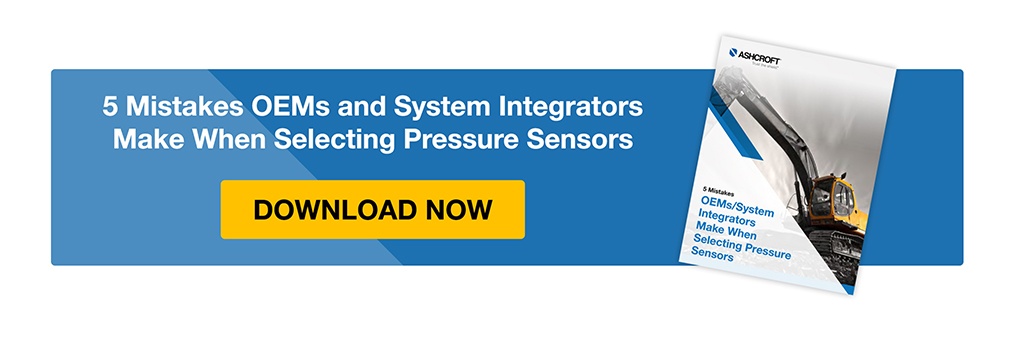
By:
Todd McPadden
Product Sales Leader, High Pressure Transducers
Published on:
October 9th, 2024
Subscribe now and get the latest blog posts delivered straight to your inbox.
How Can I Order Customized Pressure Transducers?

By:
Todd McPadden
Product Sales Leader, High Pressure Transducers
Published on:
October 9th, 2024

When you need to measure air, gas or liquid in any industrial or OEM application, you will likely need to rely on a pressure transducer with sensing technology to keep your system running smoothly. However, process media, measurements and components can vary based on your industry and your specific application.
The good news is that Ashcroft and its parent company Nagano Keiki Co. LTD (authorities in pressure measurement instrumentation) offer pressure transducers that can be customized to meet your requirements.
Read this article to learn common reasons why companies want customization of their instruments, the features of Ashcroft pressure transducers that can be tailored to your specifications and how to get started. You will also find links to additional resources that will help you learn more about these instruments.
Why customize a pressure transducer?
In many industries, the need for precise and reliable pressure measurement is critical. However, standard specifications listed for pressure transducers may not always meet the unique requirements of your specific applications. This is where customization becomes essential. Customizing a pressure transducer can provide tailored solutions that enhance performance, compatibility, and branding. Here are some common reasons why companies across different sectors might opt to customize these instruments:
- Installation and Accessibility: Ashcroft transducers can be tailored to fit specific installation layouts, making system integration and access easier in complex systems.
- Industry-Specific Requirements: Different industries, such as performance racing, fluid hydraulics, off-highway vehicles (OHV), agricultural systems, HVAC/R, building comfort control systems and bio-pharm/bio-tech as some examples, have unique demands that standard transducers may not accommodate.
- Competitive Advantage: Custom features can be designed to make it challenging for competitors to replace the part, thereby securing a competitive edge.
- Branding and Identity: Original Equipment Manufacturers (OEMs) may require transducers that feature their company name, logo, and website address to reinforce brand identity and ensure consistency across their products.
Any or all of these scenarios can help ensure your pressure transducers are perfectly aligned with your requirements.
What can be customized on a pressure transducer?
When a customer requests customization, Ashcroft offers several options:
Pressure ranges: Depending on the model you choose, transducers are available with pressure ranges from a fraction of an inch of water to 72,000 psi. These transducers can be tailored to meet your specific pressure range requirements to ensure precise measurement for various applications.
Process connections: A broad range of pressure connections is available to accommodate any number of application and installation requirements. Examples include several male and female fittings in various NPT, metric, straight and other thread/fitting configurations. If the process connection you need isn't listed on the datasheet of the transducer you want, you can inquire about further alternatives. This adaptability ensures smooth integration into various systems.
Electrical connections: Transducers can be purchased with various electrical connections, including cable, conduit, DIN, Deutsch, M12 and screw terminal among others. If you need a connection type not mentioned in our datasheet, you are welcome to inquire about its availability. This flexibility improves compatibility with a wide range of electrical configurations.
Wetted materials: Depending on the transducer model, multiple options for wetted materials may be available. This ensures compatibility with different process media and reliability in various environments.
Private labeling: Custom branding options can include company logos, part numbers, and website addresses, to help reinforce brand identity and consistency across products.
These customizable features not only ensure that the transducers meet specific application needs but also enhance performance, compatibility, and brand recognition.
3 steps to customizing your pressure transducer
Now that you know Ashcroft transducers can be customized and in what ways, you might be wondering how to initiate the process. Here's what you need to do
1. Get in touch
You can visit our official website and use the contact form to reach out. This information will be directed to your local territory manager, distributor or inside sales representative.
2. Submit your required specifications
Include a detailed list of all your requirements, including precise pressure ranges, pressure connections, electrical connections, wetted materials, and any branding needs you have. The more comprehensive and specific your submission, the better we can tailor the transducer to meet your exact requirements
3. Review and approve the transducer part specification.
Your designated Ashcroft representative will either contact you directly to request additional information or send you a draft of your request for your review and approval.
Note: For custom logos, labels and other specifications not found on standard datasheets, we will assign a code to your part number, which is a unique identifier that can only be sold to you in the future. It won’t be shared with other customers.
Ready to learn more about pressure transducers?
Now that you know Ashcroft's pressure transducers can be customized, you may still have questions. Feel free to reach out directly to one of our experts and get all your customization questions answered. In the meantime, we've compiled a few more articles about transducers that may be of interest to you.
- What are the Advantages of Ashcroft Pressure Transducers?
- What is CVD Technology and Why is it Important in OEM Applications?
- MEMS Pressure Transducer Sensor Technology
- Choosing the Right Pressure Sensor: 5 Factors to Consider
- How Much Do Pressure Transducers Cost? (6 Factors Impacting Price)
In the meantime, download our guide, 5 Mistakes OEMs and System Integrators Make When Selecting Pressure Sensors.
Todd McPadden, Product Sales Leader, High Pressure Transducers
Todd is the product manager for OEM High-Pressure Transducers with more than 19 years of experience at Ashcroft.



























